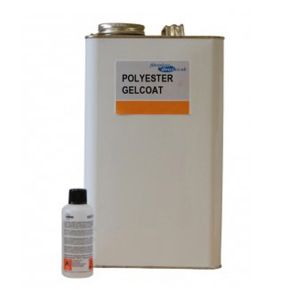
A question we are regularly asked at FibreGlassDirect is how to make a mould. There are 2 options when it comes to making a mould. The easy way and the long way! Your budget, time and number of products you require, will influence your decision on this.
Before starting, please ensure that your working area has good ventilation and that the appropriate PPE (personal protective equipment) is worn. For more information, please refer to the manufacturer’s MSDS and TDS for each product. If unsure about which products are most suitable, don’t hesitate to contact the FibreGlassDirect team who would be more than willing to help with any mould making queries.
Creating a mould from a product
When making a mould from fibreglass, a plug is used to help create the shape. The plug is the shape of the product you want your mould to create.
The first step in creating a mould from a plug is it to prep the plug! There a number of steps to this as fibreglass cannot fit around tight corners and fine details well.
Sharp corners in the product need to be rounded, any small details or small cracks or hollows should be filled in with either body filler or plasticine. The part should be sanded with a 1000 grit wet/dry sandpaper.
If you have access to pressurised air, sometimes it is helpful to drill a small 4mm hole at the bottom of the part. Forcing pressurised air through this when the part is cured can help demoulding the part. If you choose to do this, cover over the hole with a small sticker while the fibreglass is applied.
After sanding the product should be cleaned down with acetone and then buffed up to a shine using 4/5 coats of Mould Release Wax E.g. Honey Wax, using a clean white cloth.
If you want a mould that will make a number of products, it is a good idea to create a lip on the outer edge of the part to aid demoulding. This can be done by fixing a sheet of laminated wood to the edge. Remember to fillet this angle.
Once the prep work has been completed, measure and cut your chopped strand mat to fit over you plug, ensuring you leave enough to overhang the part by about 100mm each side. Leave this to one side.
Gelcoat mixed with 2% catalyst should be applied to the part at a rate of 500g/m2. If you are using this mould to make only a couple of parts, one layer is sufficient, however, if this mould it to make a lot of parts, it is advisable to apply 3 coats of gelcoat. Allow each application of gelcoat cure before applying the next. This first two should be applied in one colour and the final layer to be applied in a different colour. In the future, when sanding as part of maintaining the mould, this will give you an indication of when you are getting close to the glass in your mould.
When the gelcoat is cured (you will be able to run your fingers across the surface without them sticking, the gelcoat will remain tacky, therefore, if you touch the gelcoat you will stick to it and leave a mark), use a brush to apply the resin mixed with 2% catalyst over the gelcoat. Place the glass mat over the wetted-out area. Work more resin into the chopped strand mat using the brush and consolidate with a paddle roller to remove all trapped air and ensure that the chopped strand mat is fully wetted out. Apply subsequent layers of fibreglass as required. Usually, about 4-6 are recommended depending on size, shape and requirement of the mould. The resin used is 2.25 times the weight of the glass, so for 1m2 of 450g mat then 1kg of resin will be required. Unlike the gelcoat, the multiple layers of resin and glass mat can be applied at a time.
Due to the nature of fibreglass, edges of the mould can fold inwards over time. If you are using this mould for multiple products, to help it maintain its shape, ribs can be added to the outside of the mould.
Once the resin has cured (totally rigid, with no soft/wet patches), the part should be sanded down prior to demoulding.
After sanding down the cured fibreglass, the part can be demoulded. This means removing the part out of the mould. Care should be taken as at this stage there can be sharp strands of glass sticking out. The glass ends at the edge of the mould should be cracked away from the edge of the plug, this can be done using a wedge and a mallet to force the part from the mould.
If you had drilled the small air hole in the plug you can then use an air gun to force air into the hole which will help the mould to ‘pop’ up and release.
The excess fibreglass can then be trimmed to size, remembering to leave a lip on the mould to help de-mould your products. The gel-coated side of the mould should be compounded to a shine. Three layers of wax should be applied to the mould and a layer of blue release.
If you are using the mould for a lot of products, then it is a good idea to allow your mould cure fully before making a product from it which would be 2 weeks, however, products can be made from it the next day.
Creating a product from a mould
Ensure the mould it clean and free from dust, give a wipe with acetone on a clean cloth. This is very important as anything that is in your mould will come out on your product.
Mould release should be applied to the mould to ease the demoulding process. However, this generally only needs to be done for every fifth product. The mould should be buffed to a shine.
Use a brush to apply gelcoat at a rate of 500g/m2. This should be mixed with 2% catalyst.
After the gelcoat has cured, use a brush or a roller to apply a thin coat of resin, immediately lay the glass over the resin. Wet out the glass with more resin and consolidate with a paddle roller. More glass and resin should be applied as required, most parts would require at least 3 layers. More layers may be required for larger products.
When the resin is cured, sand down the resin using wet/dry sanding paper. If topcoat is required, it can be applied at a rate of 500g/m2. Once this is cured, the part can be demoulded in the same way as above. Once demoulded the part can then be trimmed to suit. Then you part is ready for use.
Notes for making a fibreglass mould
To ease the demoulding process, a demoulding angle of 5° should be built into the part.

A lip on the mould can also help with the demoulding process.

If it is a simple shape and you want to create a mould from scratch, then laminated wood can be used to create the plug for a mould.
Care should be taken at all stages of the application of gelcoat and resin and glass to avoid air bubbles as this will reduce the lifespan of your mould or reduce the quality of the product coming from it. Any imperfections on the mould will come out in the product so it is a good idea to spend some time on making your mould.
Fibreglass cannot fit around tight corners and into fine detail. It is recommended that all edges be rounded off and a radius is put into all corners, a minimum radius of 10mm is recommended.
Before making your mould think about what finish you want from your product. There are two finishes in a moulded part, one with a smooth gelcoat that touches the moulds surface while moulding, and the opposite side which can be a raw glass finish or a top coated finish, this is not as smooth as the gel coated finish. This will dictate whether you want a male or a female mould.








